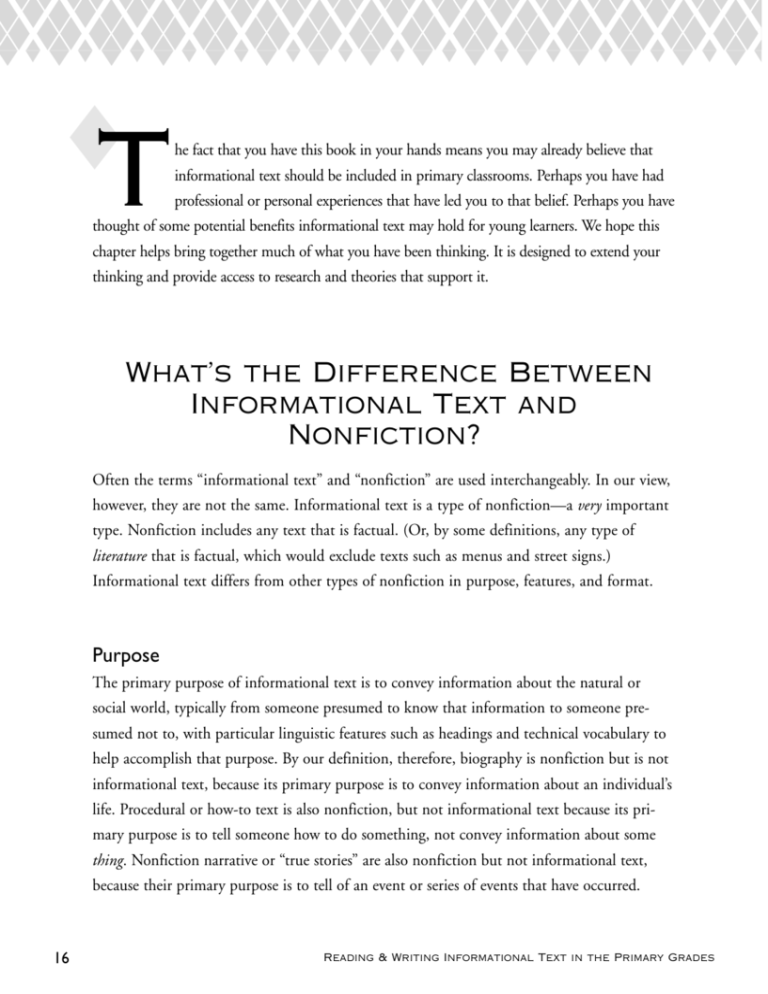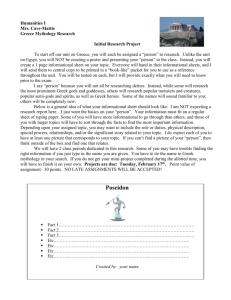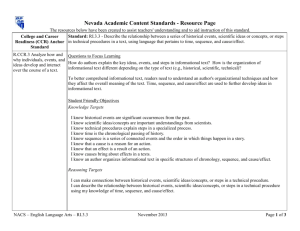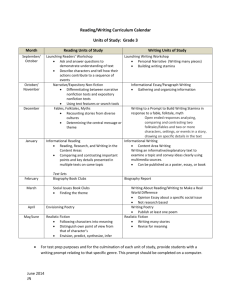What's the Difference Between Informational Text and
advertisement

◆T he fact that you have this book in your hands means you may already believe that informational text should be included in primary classrooms. Perhaps you have had professional or personal experiences that have led you to that belief. Perhaps you have thought of some potential benefits informational text may hold for young learners. We hope this chapter helps bring together much of what you have been thinking. It is designed to extend your thinking and provide access to research and theories that support it. What’s the Difference Between Informational Text and Nonfiction? Often the terms “informational text” and “nonfiction” are used interchangeably. In our view, however, they are not the same. Informational text is a type of nonfiction—a very important type. Nonfiction includes any text that is factual. (Or, by some definitions, any type of literature that is factual, which would exclude texts such as menus and street signs.) Informational text differs from other types of nonfiction in purpose, features, and format. Purpose The primary purpose of informational text is to convey information about the natural or social world, typically from someone presumed to know that information to someone presumed not to, with particular linguistic features such as headings and technical vocabulary to help accomplish that purpose. By our definition, therefore, biography is nonfiction but is not informational text, because its primary purpose is to convey information about an individual’s life. Procedural or how-to text is also nonfiction, but not informational text because its primary purpose is to tell someone how to do something, not convey information about some thing. Nonfiction narrative or “true stories” are also nonfiction but not informational text, because their primary purpose is to tell of an event or series of events that have occurred. 16 Reading & Writing Informational Text in the Primary Grades This is not to say that biography, procedural text, nonfiction narrative, and other types of nonfiction are not important; they are just not the same as informational text. Features It is important to talk about the different types or genres of nonfiction not only because they have different purposes, but because they have different features to achieve those purposes. For example, biographies typically focus on a single individual and specific points in time. In contrast, informational texts, as we define them, talk about whole classes of things and in a timeless way (for example, “Sharks live in water.”); they therefore have a generalizing quality. Other com- By our definition, informational text is: ◆ text whose primary purpose is to convey information about the natural and social world. mon features of informational ◆ text that typically has characteristic features texts include presentation and such as addressing whole classes of things in repetition of a topic or theme; a timeless way. descriptions of attributes and ◆ text that comes in many different formats, characteristic events; compara- including books, magazines, handouts, tive/contrastive and classifactory brochures, CD-ROMs, and the Internet. structures; technical vocabulary; realistic illustrations or photographs; labels and captions; navigational aids such as indexes, page numbers, and headings; and various graphical devices such as diagrams, tables, and charts. Many of these are not found in other types of nonfiction. (See Chapter 6 for more Informational text is not: ◆ text whose primary purpose is something other than to convey information about the natural and social world, such as telling about an individual's life, an event or series of events, or how to do something. ◆ text that always has particular features; instead, features vary by text. ◆ only books. information.) Chapter 1: Why Include Informational Text in the Primary Classroom? 17 What Do We Mean by Research-Based Practice? Throughout this book, we use the term research, so we should say something about what we mean by it. To us, research is the systematic collection and analysis of data for the purpose of addressing a question. For example, to address the question “How much time do primary-grade children spend with informational text in school?” researchers might collect data by observing in classrooms or administering surveys. By applying specific procedures for collecting data, and having specific procedures for analyzing them, those researchers are being systematic. They report conclusions based not just on what they think or guess, but on the data they collect and analyze. In this book we focus on practices that are research based. This means that, whenever possible, the practices we recommend (for example, improving children’s reading comprehension) have been tested in one or more research studies and shown to be effective. In some cases they have not been tested themselves through research. In such cases, the practices are very closely related to practices that have been tested. For example, sometimes we recommend practices to use with informational text which are modified versions of practices that have been shown to be effective (usually at raising student achievement) using narrative text. We can’t guarantee that those practices will be effective with informational text, and indeed we welcome research to find out, but for now they provide the best basis we have. For each major practice we recommend, we tell you about the research upon which it is based.We hope that you will expect the same from other resources you read on using informational text in the primary grades. Along the way, be sure to draw on your own experiences and judgments, as research alone cannot provide all the answers. 18 Reading & Writing Informational Text in the Primary Grades Format Within informational text, there are several different types of text that might be considered informational text genres or subgenres. For example, there are reference books such as encyclopedias, field guides, and so on. There are “all about” books, such as some of those by Gail Gibbons. There are also books we call process-informational books. These include books about how a particular animal develops from conception to adulthood or about how some substance is created or transformed. And many informational texts are not books at all, but rather magazines or newspapers, posters or pamphlets, Web sites or CD-ROMs, and so on. The format of the text can affect that text and how it is read or written; for example, informational text on Web sites is usually informational hypertext. We include many different types of informational text in this book, and you will probably identify many more in your own classroom and experiences. There are professional books that focus on forms of nonfiction collectively, and these are very useful. (See Appendix B.) However, we believe that informational text is so important, and that there is so much to say about the teaching and learning issues surrounding it, that it deserves a book unto itself. Although many of the principles and practices we discuss—such as teaching comprehension strategies, making reading-writing connections, and attending to the classroom environment—can easily be applied to other types of text, we hope you agree that teaching and learning with informational text is, indeed, important and complex enough to merit its own book. Why Think About Genres Children Encounter in the Primary Grades? There are many different dimensions of text that might influence a young child’s ability to read that text (Hiebert, 1999; Purcell-Gates & Duke, in press), such as its predictability, decodability, and illustrations. What makes us think that genre is one of the dimensions of text to be concerned about? For the answer, we look to theory and research. Genre theorists believe that differences among texts develop based on the purposes for those texts (e.g., Chapter 1: Why Include Informational Text in the Primary Classroom? 19 Halliday & Hasan, 1985; Miller, 1984). A text written for the purpose of advertising a new car, for example, is fundamentally different from a text written for the purpose of explaining how that car works, which is in turn fundamentally different from a text that chronicles someone’s adventures driving that car across the country. These texts have very different purposes, are written for different situations, and have very different characteristics. Genre research indicates that even young children are sensitive to those differences. One of our favorite examples of this comes from a three-year-old girl who scribble-wrote two texts. One had only short scribbles down only the left-hand side of the page. The other had long scribbles that extended across the page. She identified the first as a shopping list and the second as a story! (Harste, Woodward, & Burke, 1984, p. 157) Although not yet writing beyond scribbles, this child already showed awareness of genre features. There are many documented examples of young children producing texts characteristic of particular genres, producing or using genres appropriate to their purposes, talking about differences between genres, and so on. (See Duke & Purcell-Gates, in press, for further discussion.) Why Include More Informational Text in Primary Classrooms? Exposing children to a variety of genres may be wise, but why focus on informational text in particular? There are a number of arguments for doing so. Some of these arguments have a more solid research base than others, and some may be more compelling than others. But based on the research and theories available at this point, we feel children should encounter more informational text in the primary grades for the reasons explained below: Informational text is key to success in later schooling. We have all heard that from around fourth grade on, “reading to learn” is a major focus in school (Chall, 1983). Students encounter more textbooks and other forms of informational text as they move through the grades. The tests they take contain increasingly more difficult informational texts. College curricula are replete with a variety of informational readings. If we include more information- 20 Reading & Writing Informational Text in the Primary Grades al text in early schooling, we put children in a better position to handle the reading and writing demands of their later schooling. We would like to see a day when children “read to learn” and “learn to read” from the earliest days of school and throughout their school careers. Informational text is ubiquitous in society. Several studies have looked at the kinds of things people write outside of school—what children and adults read and write in their workplaces, homes, and communities. Again and again these studies have shown that adults read a great deal of nonfiction, including informational text (e.g., Venezky, 1982, Smith, 2000). This is not likely to change and, in fact, in our increasingly information-based economy, it may only increase. According to one study (Kamil & Lane, 1998), 96 percent of the text on the World Wide Web is expository. If we are going to prepare children for this world, we need to be serious about teaching them to read and write informational text. It may not be difficult to convince children of the need for this, as we draw their attention to the informational text that surrounds them in their world. Informational text is preferred reading material for some children. When researchers investigate the kinds of texts children like to read, they’ve found something that isn’t surprising: Different children have different reading preferences. Some children seem to prefer informational text, some seem to prefer narrative text, many don’t seem to have preferences for any particular genre. For those children who prefer informational text—children Ron Jobe and Mary Dayton-Sakari (2002) call “Info-Kids”—including more informational text in classrooms may improve attitudes toward reading and even serve as a catalyst for overall literacy development (Caswell & Duke, 1998). Informational text often addresses children’s interests and questions. Regardless of a child’s text preference, when the text’s topic is of particular interest to that child, his or her reading is likely to improve (Schiefele, Krapp, & Winteler, 1992). Not surprisingly, then, approaches that emphasize reading for the purpose of addressing real questions children have about their world tend to lead to higher achievement and motivation (e.g., Guthrie, Van Meter, McCann, Wigfield, Bennett, Poundstone, et al., 1996). Including more informational text in classrooms may help us address the interests and questions of more of our students. Chapter 1: Why Include Informational Text in the Primary Classroom? 21







